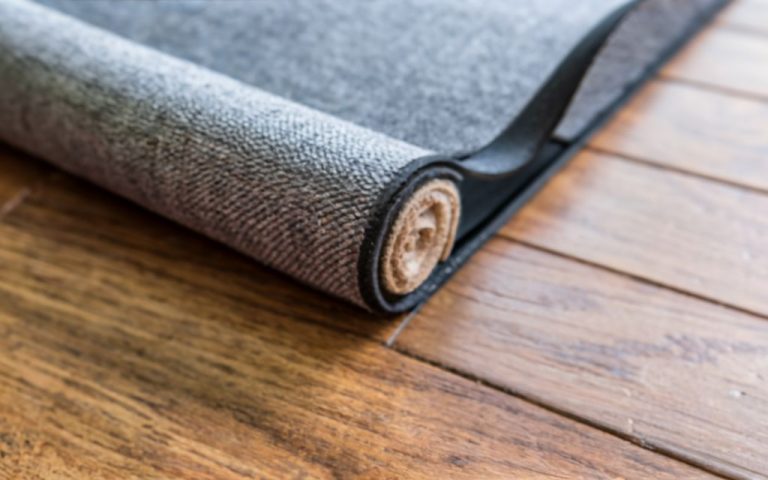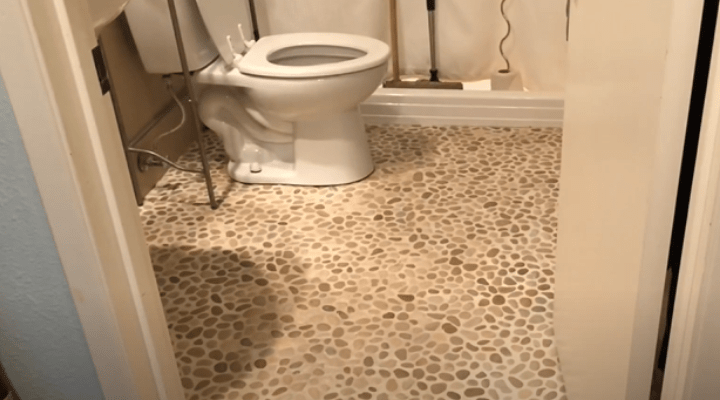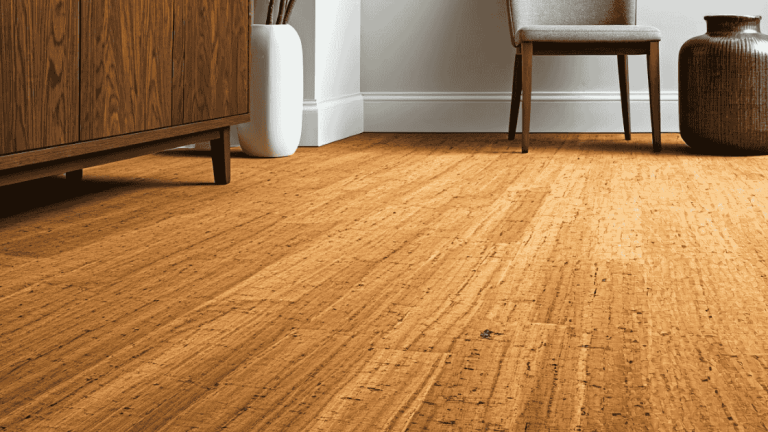How Flat Does Subfloor Need to Be for Vinyl Plank?
The subfloor for vinyl plank should be flat within a tolerance of 1/8 or 3/16 inches over a 10-foot span. 1/8 Inches is most preferred for LVP and Most Vinyl Plank.
While there are some considerations in the subfloor. Like the subfloor is concrete or wood. But generally, the flatness of the subfloor can be 1/8 or 3/16 inch over a 10-foot span (3 mm to 5 mm over 3 meters).
General Guidelines for Subfloor Flatness for Vinyl Plank Flooring:
As the general guidelines that most manufacturers recommend a subfloor flatness is 1/8 inch over a 10-foot span, ensuring a level surface for the vinyl planks or tiles. It can vary between the two supports or what we call span.
If the span gap increases to 6, 8, 10, 12, etc the subfloor flatness will also increase. Here is a table that guides you based on spans:
Maximum Allowable Deviation Based on Span:
| Span (feet/meters) | Maximum Allowable Deviation for Vinyl Plank |
|---|---|
| 6 feet (1.8 meters) | 1/8 inch (3 mm) |
| 8 feet (2.4 meters) | 3/16 inch (5 mm) |
| 10 feet (3 meters) | 1/8 inch – 1/4 inch (3 mm – 6 mm) |
| 12 feet (3.6 meters) | 1/4 inch – 5/16 inch (6 mm – 8 mm) |
| 14 feet (4.2 meters) | 5/16 inch – 3/8 inch (8 mm – 10 mm) |
| 16 feet (4.8 meters) | 5/16 inch – 7/16 inch (8 mm – 11 mm) |
On the other hand, It is also dependable on subfloor types. Generally, the most used types are concrete and Wood. Hence, concrete is more flatter than wood. That’s why the concrete subfloor is considered to be 1/8 or 3/16 inch. But for wood, it is considered to be 3/16 inches in a 10-foot span.
Maximum Allowed Deviation Based on Subfloor Types:
| Subfloor Type | Maximum Allowable Deviation |
|---|---|
| Concrete Subfloor | 1/8″ in 6 feet or 3mm in 2 meters |
| Wood Subfloor | 1/8″ in 10 feet or 3mm in 3 meters |
| Ceramic Tile Subfloor | 1/4″ in 6 feet or 6mm in 2 meters |
| Vinyl Tile Subfloor | 1/8″ in 6 feet or 3mm in 2 meters |
It depends on you and some general criteria for subfloor installation. By the way, for more perfect achievement it’s preferable to discuss a professional or follow manufacturers guidelines.

Is A Flat Subfloor Needs Important Vinyl Plank:
However, Yes flat subfloor needs to be extremely important for Vinyl Plank Flooring. It will help much more to make VPF smooth, accurate, comfort ness, etc. In Addition, Many manufacturers recommended using a subfloor for the warranty to be valid.
Here are some important factors that subfloor should be installed in VPF:
- Smooth and Professional Installation: Unevenness in the subfloor will telegraph through the vinyl plank flooring, resulting in a bumpy and unprofessional-looking installation. This can also lead to cracking and other problems with the flooring over time.
- Long-lasting Performance: A flat subfloor helps to distribute the weight of the vinyl plank flooring evenly, preventing premature wear and tear. It also reduces the stress on the locking system of the planks, which can prevent them from clicking loose.
- Reduced Noise: Vinyl plank flooring is naturally quieter than other types of flooring, such as hardwood. However, an uneven subfloor can cause the planks to squeak or creak when walked on. A flat subfloor helps to minimize these noises.
- Improved Comfort: A flat subfloor provides a more comfortable surface to walk on than an uneven subfloor. This is especially important for people with mobility issues.
- Warranty Coverage: Many vinyl plank flooring manufacturers require that the subfloor be flat for the warranty to be valid. Failure to meet this requirement could void the warranty and leave you responsible for any repairs or replacements.
Guide to Making Subfloor for Vinyl Plank:
Making a Subfloor for Vinyl Plank is important. But it is more important to install the subfloor perfectly. So it is need to some calculations for leveling the surface and flatness for the subfloor. Also need some tools to make it as possible.
However, A subfloor professional can ensure this best result. By the way, here is a general guide to installing subfloor process:
Subfloor Preparation
Subfloor preparation is a crucial step in ensuring a successful vinyl plank flooring installation. The quality of your subfloor directly impacts the long-term stability and aesthetic appeal of your vinyl plank flooring. So at this step, you need to decide which type of subfloor you want to use.
As per we also discuss about it. So, you can use concrete or wood. Because these two are the best and most used type of subfloor.
The Condition Checking Before doing
The condition of the subfloor is integral to the overall performance and longevity of your vinyl plank flooring. A flat and smooth subfloor provides a stable foundation for the flooring, preventing issues such as uneven seams, gaps, or premature wear.
This ensures the visual integrity and durability of the installation, giving you peace of mind that your floors will stand the test of time.
Be careful and Some Risk Of Imperfections
Inadequate subfloor preparation can lead to imperfections that may compromise the installation of vinyl plank flooring. Uneven subfloors can result in visible lippage between planks, which not only affects the visual appeal but also poses a tripping hazard.
Additionally, irregularities in the subfloor can cause the planks to flex or shift, leading to premature wear and potential damage to the flooring over time. Now it is time to measure subfloor flatness to best output.
Tools For Measuring Subfloor Flatness:
There are several tools available for measuring subfloor flatness, each serving a different purpose. Let’s explore these tools in more detail to understand their role in achieving an ideal subfloor for vinyl plank installation.
Straightedge And Flashlight
One of the simplest ways to check subfloor flatness is by using a straightedge and a flashlight. By placing the straightedge across the subfloor and shining a light underneath, any gaps or uneven areas are easily identified by observing the light passing through.
This method helps in locating low spots and identifying areas requiring further leveling. It’s a cost-effective way to get an initial assessment of the subfloor’s flatness.
Carpenter’s Level
A carpenter’s level is another essential tool for measuring subfloor flatness. It provides a more accurate assessment of the subfloor’s levelness by indicating any inclines or declines.
Using a carpenter’s level helps ensure that the subfloor meets the necessary flatness requirements for vinyl plank flooring installation. It’s especially useful for identifying gradual slopes or uneven areas that may not be easily noticeable to the naked eye.
Digital Laser Level
For a more precise measurement, a digital laser level can be employed to assess subfloor flatness. This advanced tool emits a laser beam to determine the levelness of the subfloor, providing accurate measurements and identifying even the smallest deviations. Its digital capabilities make it an efficient choice for obtaining precise readings, particularly when working on large or complex subfloor surfaces.
Self-leveling Underlayment
In cases where the subfloor does not meet the required flatness standards for vinyl plank installation, self-leveling underlayment can be used to rectify the issues.
This specialized underlayment material automatically spreads and levels itself, creating a smooth and flat surface for the vinyl plank flooring. It’s an effective solution for addressing moderate to severe subfloor irregularities, ensuring a stable foundation for the installation.
Subfloor Inspection Process
Inspecting the subfloor to ensure a smooth and stable surface. This process involves several important steps, including the removal of surface debris, checking for moisture and subfloor stability, identifying high and low spots, and measuring and assessing the overall condition.
Surface Debris Removal
Inspect the subfloor to remove any surface debris such as dust, dirt, or leftover adhesive from previous flooring installations. An uneven surface can cause vinyl plank flooring to be uneven, so it’s essential to remove any debris that could affect the flatness of the subfloor and the new vinyl plank installation.
Moisture And Subfloor Stability Check
Check the moisture levels of the subfloor using a moisture meter to ensure it falls within the manufacturer’s recommended range. In addition, assess the stability of the subfloor by walking across it and listening for creaks or feeling for movement.
Identifying High And Low Spots
Using a straight edge or a level, identify any high or low spots on the subfloor. This step is crucial as vinyl plank flooring requires a very flat surface to prevent any bumps or uneven areas that may cause the planks to not lay flat or become damaged over time.
Measurement And Assessment Tips
Measure the subfloor to identify any discrepancies in height or unevenness. Assess the overall condition of the subfloor to determine if any repairs or leveling are necessary before proceeding with the vinyl plank installation.
Addressing Subfloor Imperfections
Subfloor Flatness is important to achieve perfection. So the things that can achieve an ideal foundation for VPF. Here’s how to achieve the ideal foundation for your vinyl plank flooring:
Patching Low Spots
Low spots in the subfloor can lead to uneven flooring. To patch low spots:
- Clean the low spots to remove any debris.
- Apply a patching compound to fill in the low areas.
- Use a trowel to ensure the compound is evenly spread and level with the rest of the subfloor.
Sanding High Spots
If the subfloor has high spots, sanding can help create a smoother surface:
- Identify the high spots by running a straight edge or level across the subfloor.
- Use a floor sander or a belt sander to gently sand down the high areas until the subfloor is even.
Filling Cracks And Gaps
To ensure a seamless installation, any cracks or gaps in the subfloor should be filled:
- Fill small cracks with a latex-based caulking compound and spread it evenly with a putty knife.
- For larger gaps, use a combination of wood filler and wood shims to create a smooth, even surface.
Using Floor Leveling Compound
In cases where the subfloor has significant imperfections, a floor-leveling compound can provide a uniform surface:
- Prepare the subfloor by cleaning and priming it.
- Mix the leveling compound according to the manufacturer’s instructions.
- Pour and spread the compound evenly over the subfloor, following the recommended thickness.
Testing Subfloor Flatness
Testing the flatness of the subfloor is an important step in ensuring a successful vinyl plank installation. An uneven subfloor can cause issues such as gaps, buckling, or premature wear in the vinyl planks. In this section, we will explore different techniques for testing subfloor flatness to guarantee a smooth and problem-free vinyl plank installation.
Dry-layout Technique
The dry-layout technique involves laying full-size vinyl planks directly on the subfloor without adhesive. This allows you to visually inspect for any deviations in the subfloor’s flatness. Be sure to stagger the planks and leave gaps at the walls to mimic a real installation. Observe for any gaps or raised edges between the planks, as these can indicate unevenness in the subfloor.
Light And Shadow Examination
An effective way to detect subfloor irregularities is by conducting a light and shadow examination. Using a strong light source positioned parallel to the floor, observe the shadows cast by the subfloor. Any undulations or imperfections will be highlighted by the contrast of light and shadow, indicating areas that may require leveling.
Leveling Trial With Vinyl Plank Samples
One practical method of testing subfloor flatness is by using samples of the vinyl planks themselves. Place the samples in various areas across the subfloor and visually inspect for consistent contact with the subfloor. Gaps or rocking motion of the samples suggest unevenness, prompting the need for leveling the subfloor.
Precision Testing Tools
For a more precise assessment of subfloor flatness, consider using precision testing tools such as a straightedge, laser level, or a self-leveling floor compound. These tools can provide accurate measurements and identify specific areas that require attention, ensuring that the subfloor meets the necessary flatness requirements for vinyl plank installation.
Lastly…
Installing a subfloor for VPF is important for perfection. Following the guide you can ensure perfection as much as possible. Taking a professional is more crucial in this situation.
Vinyl plank flooring will best be installed if the subfloor is perfectly done. So, taking time to make decisions, and implementing the perfection.










